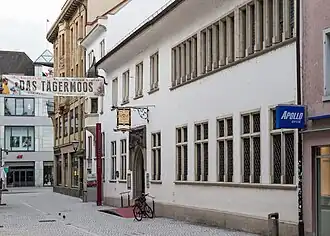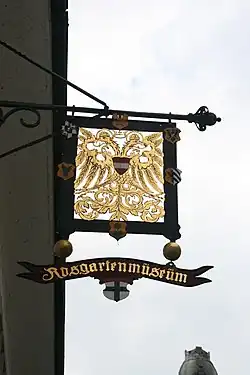Rosgartenmuseum
 The Rosgartenmuseum in Konstanz | |
| Established | 1870 |
|---|---|
| Location | Konstanz, Germany |
| Coordinates | 47°39′35.6″N 9°10′29.3″E / 47.659889°N 9.174806°E |
The Rosgartenmuseum (lit. 'rose-garden museum') is an art gallery and cultural centre at 3–5 Rosgartenstraße in Konstanz, Germany. It is also a local history museum for the city and the surrounding Bodensee region. In 2014 had 100,028 visitors.[1] It holds annual exhibitions on the region's art history and cultural history..[2]
It is one of the oldest museums of its kind in the region. It was founded by the city councillor and pharmacist Ludwig Leiner in 1870. The museum was managed by Leiner and then by his sons Otto and Bruno.[3]
It is housed in a house called "Zum Rosgarten" which was built in 1324 and served as the guildhall for butchers, grocers, pharmacists, potters and ropemakers in the medieval era. In 1454 one of its walls was knocked through to join that house to the next-door house called "Zum Schwarzen Widder" and the present guildhall room was created.
Collections

It houses documents, artworks and around 50,000 objects on the history of the city and region. The core of the collection was originally collected by Leiner and other private collectors. They range from Neolithic archaeological objects to medieval altarpieces, wood carvings from churches, paintings by artists born and active in Konstanz, 19th and 20th century everyday objects, and private letters and photographs by historical figures.
Rooms
"Historic Hall" or "Leiner Hall"
A museum within a museum, it holds geological, palaeontological and prehistoric archaeological objects from prehistory, ranging from the origins of life on earth to human life in the Bronze Age. It focusses on fossils from the Franconian Jura, late Iron Age finds and objects from the many stilt houses of the Neolithic and Bronze Age.
Guild Hall
This room acts as the museum's 'parlour'. In the middle ages it served as a meeting hall and drinking room for the guild and its guests. The wall panelling is adorned with coats of arms of the Swabian League and some Konstanz families. The recessed painted-glass 'Kabinettscheiben' date from the 17th century.
Urban expansion
Konstanz began as a simple Celtic settlement before becoming a Roman military camp. Churches, monasteries were added in the middle ages (as shown by a scale model of the city at that time), along with a harbour and railways far later. The modern era also saw the addition of department stores and factories.
Medieval era
The city and its inhabitants were ruled by its Prince-Bishops for over 500 years, starting with the bishopric's foundation in 600 AD. En route to becoming a free city in the Holy Roman Empire, in 1192 its citizens convinced Henry IV to exempt them from all episcopal taxes. The first mayor was elected in 1308 and after the Imperial Ban of 1508 Charles V made Konstanz a Landstadt in lower Austria. Finally Napoleon annexed it to the Grand Duchy of Baden in 1806.
Konstanz's Medieval Art
As the bishopric's centre, Konstanz was an important client for sculptors' workshops and painters' studios, including those of Peter Murer and Rudolf Stahel, which produced religious panel paintings. The so-called 'Blarer's Founder's Plaque' is also attributed to Stahel's studio and commemorates the benefactors and donors to the Konstanz's hospital, founded in 1225.
Richental Chronicle
This richly-illustrated chronicle on large-format paper recounts the events surrounding the 1414-1418 Council of Constance in the Upper German-Alemannic dialect. It was created around 1464 by Ulrich von Richental, a citizen of the city, and includes both major and everyday events of the time in text and coloured pen and ink drawings.
Reformation and Catholic Reformation
Martin Luther's teachings fell on fertile ground in Konstanz, with its citizens and council converting to them. When that council increasingly forbade Catholic practices the bishop left the city to live in Meersburg. This left a strict disciplinary Reformed life in Konstanz.
Politically the council sought membership of the Schmalkaldic League. The conflict led Charles V to come to the city, removing its imperial freedom, annexing it to Austria, re-imposing the Catholic religion and forcing many reformers and Protestant families to flee the city.
Crafts in Konstanz
In the 17th-century many über-local handicraft items were produced in the city, including small sculptures by Christoph Daniel Schenck and Hans Zürn.
Konstanz's art in the 18th and 19th centuries
In this era Konstanz produced artists admired across Germany. The display mainly focuses on the Baroque painters Franz Ludwig Hermann and Marie Ellenrieder. The latter was the first woman to be admitted to the Munich Art Academy to study and became court painter to the Grand Dukes of Baden Baden as well as a sought after portraitist. Konstanz also produced the Mosbrugger family of painters at this time - portraits by Friedrich Mosbrugger are on show.
"Konstanz en route to the modern era"
Emigrants from Geneva late in the 18th century brought fresh life to the city's economy, with the following century bringing technical innovations such as steamboats and a railway. Even more impetus was provided by the election of progressive lawyer Carl Hüetlin as mayor in 1832, the foundation of a savings bank and the construction of a harbour. The city also breached its medieval towers and walls to expand.
Napoleon III
The last French emperor Louis Napoléon Bonaparte at Arenenberg Castle near Konstanz. The museum has his winter sleigh and other memorabilia such as his slippers, snuff box and a glass with the monogram of his mother Hortense de Beauharnais.
Konstanz in the Nazi Era
Most of the city's citizens had reconciled themselves to Hitler's "dictatorship of convenience" but in 1939 fears of a coming war shaped their lives. State terror was visible everywhere - Jewish merchants' shops had been "Aryanised" and politically conspicuous neighbours were visited by the Gestapo. The display focuses on forgotten victims and on courageous people who smuggled refugees across the German-Swiss border. One of these was Johann Georg Elser, who also made a failed attempt on 8 November 1939 to assassinate Hitler - he was arrested the same day in Konstanz.
Directors
- 1955–1983 Sigrid von Blanckenhagen (née Leiner, 1918–2005)
- 1983–2006 Elisabeth von Gleichenstein
- 2006–present Tobias Engelsing
Bibliography (in German)
- Verena Nübling: Die Pfahlbausammlung Ludwig Leiner im Rosgartenmuseum Konstanz – ein Kulturdenkmal von besonderer Bedeutung. In: Denkmalpflege in Baden-Württemberg. Band 29, 2000, S. 207–209.
- Tatiana Sfedu: Museumsgründung und bürgerliches Selbstverständnis. Die Familie Leiner und das Rosgartenmuseum in Konstanz. Dissertation, Universität Konstanz 2006 (Volltext).
- Tatiana Sfedu: Ein Konstanzer Bürgerwerk. Das Rosgartenmuseum seit Ludwig Leiner. Universitätsverlag Konstanz, Konstanz 2007, ISBN 978-3-89669-640-3.
External links (in German)
References
- ^ (in German) Michael Lünstroth (2015-01-31), "Neuer Besucherrekord in den Konstanzer Museen", Südkurier, p. 23, retrieved 21 February 2015
- ^ (in German) "Museumsrundgang". Rosgartenmuseum.
- ^ (in German) „Kostbarkeiten aus 1000 Jahren“. In: Konstanzer Amtsblatt, 8. Juli 2020.
- ^ (in German) "Museumsgeschichte". Rosgartenmuseum.